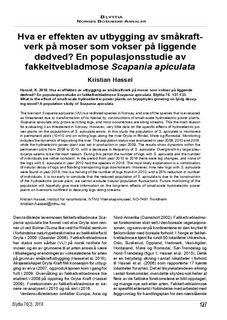| dc.contributor.author | Hassel, Kristian | |
| dc.date.accessioned | 2019-04-05T08:09:29Z | |
| dc.date.available | 2019-04-05T08:09:29Z | |
| dc.date.created | 2018-09-13T11:37:41Z | |
| dc.date.issued | 2018 | |
| dc.identifier.citation | Blyttia : Norsk botanisk forenings tidsskrift. 2018, 76 127-133. | nb_NO |
| dc.identifier.issn | 0006-5269 | |
| dc.identifier.uri | http://hdl.handle.net/11250/2593420 | |
| dc.description.abstract | The liverwort Scapania apiculata (VU) is a redlisted species in Norway, and one of the species that is evaluated as threatened due to transformation of its habitat by constructions of small-scale hydroelectric power plants. Scapania apiculata only grows to rotting logs, and most occurrences are along streams. This the main reason for evaluating it as threatened in Norway. However, very little data on the specific effects of hydroelectric power plants on the populations of S. apiculata exists. In this study the population of S. apiculata is monitored in permanent plots (10×10 cm) on rotting logs along the river Gryta in Rindal, Møre og Romsdal. Monitoring includes the dynamics of logs along the river. The population status was evaluated in year 2008, 2010 and 2016, while the hydroelectric power plant was set in production in year 2009. The results show dynamics within the permanent plots from 2008 to 2010, with a decrease in frequency of S. apiculata. Overgrowth by large pleurocarps seems to be the main reason. During this period the number of logs with S. apiculata and the number of individuals are rather constant. In the period from year 2010 to 2016 there were big changes, and none of the logs with S. apiculata in year 2010 had the species in 2016. The most likely explanation is a combination of natural decay of logs and flooding transporting logs downstream. However, nine new logs with S. apiculata were found in year 2016, this is a halving of the number of logs found in 2010, and a 25% reduction in number of individuals. It is too early to conclude that the reduced population of S. apiculata is due to the construction of the hydroelectric power plant, we cannot exclude natural population fluctuations. Future monitoring of the population will hopefully give more information on the long-term effects of small-scale hydroelectric power plants on liverworts confined to decaying logs along streams | nb_NO |
| dc.language.iso | nob | nb_NO |
| dc.publisher | Norsk Botanisk Forening (Norwegian Botanical Society) | nb_NO |
| dc.title | Hva er effekten av småkraftverkutbygging på moser som vokser på liggende dødved? Et populasjonsstudie av fakkeltvebladmose Scapania apiculata | nb_NO |
| dc.type | Journal article | nb_NO |
| dc.type | Peer reviewed | nb_NO |
| dc.description.version | publishedVersion | nb_NO |
| dc.source.pagenumber | 127-133 | nb_NO |
| dc.source.volume | 76 | nb_NO |
| dc.source.journal | Blyttia : Norsk botanisk forenings tidsskrift | nb_NO |
| dc.identifier.cristin | 1609141 | |
| dc.description.localcode | © Norwegian Botanical Association | nb_NO |
| cristin.unitcode | 194,31,10,0 | |
| cristin.unitname | Institutt for naturhistorie | |
| cristin.ispublished | true | |
| cristin.fulltext | postprint | |
| cristin.qualitycode | 1 | |
